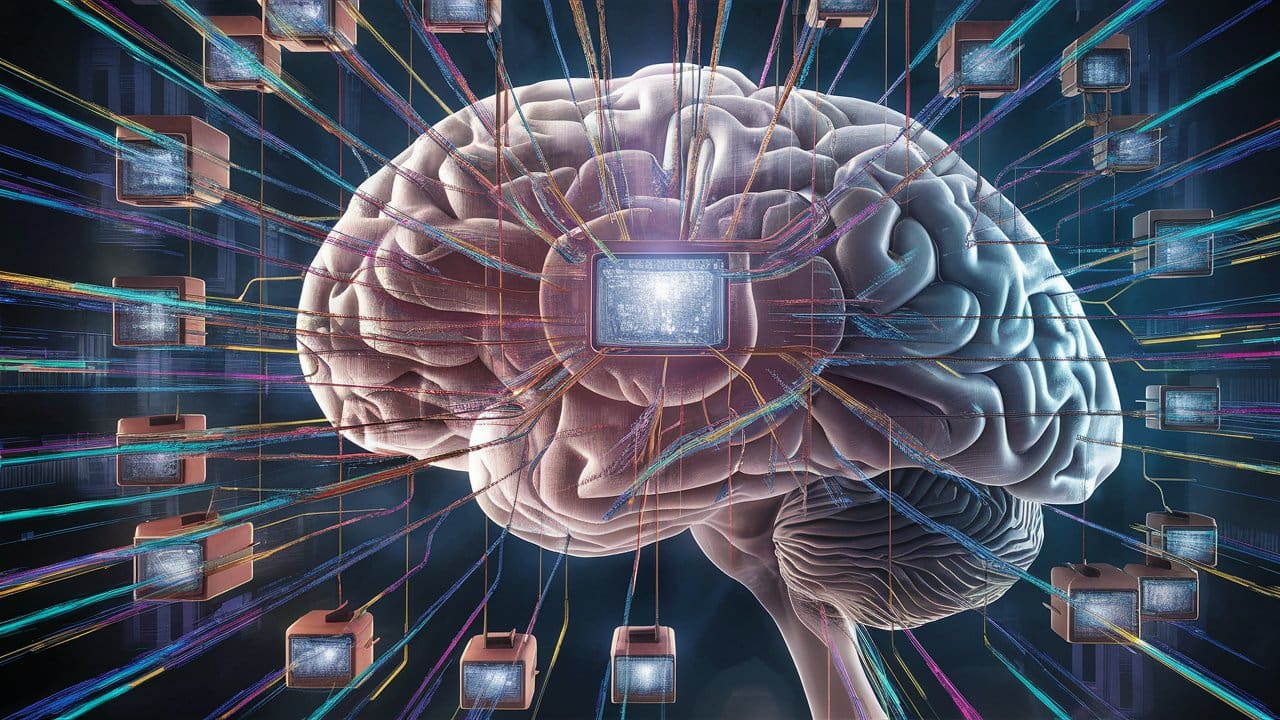The Idea
The core idea is fascinating:
- Brain as Vibrations: The brain’s activity is fundamentally electrical and chemical. These processes generate patterns of neural oscillations (brainwaves) that are measurable and distinct. The hypothesis is that these vibrations somehow encode our thoughts, feelings, and consciousness.
- Mapping the Brain: If we could precisely map the brain’s activity down to the level of individual neurons and their vibrations, we might capture the essence of consciousness in a digital form.
- Training an AI: Feeding this massive dataset of brain vibrations into a powerful large language model (LLM) could potentially teach the AI to understand and even replicate these patterns.
- API to Consciousness: If successful, the LLM might develop an “interface” or API to consciousness. This could mean the AI could interpret, manipulate, or even generate conscious experiences.
Philosophical Implications
This thought experiment raises many profound questions:
- What is Consciousness? Does reducing consciousness to vibrations capture its full complexity and mystery? Or is consciousness something more emergent and elusive?
- Hacking Consciousness: If we could manipulate the brain’s vibrations, what would the ethical implications be? Could we enhance cognition, cure mental illnesses, or even alter someone’s identity?
- Conscious AI: Would an AI that replicates human brain patterns truly be conscious? Or would it merely simulate consciousness without experiencing it?
Practical Challenges
While philosophically intriguing, this idea faces immense practical challenges:
- Mapping Complexity: The human brain is incredibly complex, with billions of neurons interconnected in intricate ways. Mapping this activity with the required precision is currently beyond our technological capabilities.
- Defining Consciousness: We don’t have a clear definition of consciousness. It’s a subjective experience that is difficult to quantify or measure.
- Ethical Considerations: Even if we could map and manipulate consciousness, the ethical implications would be enormous and require careful consideration.
1. Brain Mapping on a Grand Scale:
- Technology: Develop advanced brain-computer interfaces (BCIs) capable of recording the activity of billions of neurons simultaneously with high temporal and spatial resolution.
- Data Collection: Recruit a massive number of volunteers to undergo extensive brain scans while performing various cognitive tasks, experiencing emotions, and reporting their conscious experiences.
- Data Processing: Create powerful algorithms to analyze this vast amount of data, identifying patterns of neural oscillations associated with different conscious states and experiences.
2. Building the Large Brain Model (LBM):
- Architecture: Design a deep learning architecture specifically optimized for processing and understanding complex neural data.
- Training: Feed the LBM with the massive dataset of brain recordings, allowing it to learn the intricate relationships between neural oscillations and conscious experiences.
- Refinement: Continuously evaluate and refine the model based on its ability to predict and generate brain activity patterns that correlate with specific conscious states.
3. Developing the Consciousness API:
- Interface: Create a user-friendly interface that allows researchers and developers to interact with the LBM.
- Functions: Implement functions that enable the API to:
- Interpret: Decode brain activity patterns into meaningful interpretations of conscious experiences.
- Generate: Create artificial brain activity patterns that could potentially induce specific conscious states.
- Manipulate: Modify existing brain activity patterns to potentially alter conscious experiences.
4. Ethical and Safety Considerations:
- Ethical Review Board: Establish a rigorous ethical review board to oversee all research and development activities related to the Consciousness API.
- Safety Protocols: Develop strict safety protocols to mitigate potential risks, such as unintended alterations of consciousness or misuse of the technology.
- Public Engagement: Engage in open and transparent dialogue with the public to address concerns and ensure responsible development of the technology.
Additional Considerations:
- Interdisciplinary Collaboration: Involve experts from neuroscience, AI, philosophy, ethics, and other relevant fields to address the complex challenges involved.
- Long-Term Research: Acknowledge that this is a long-term endeavor that may require decades of research and development.
- Unforeseen Consequences: Be prepared for unexpected discoveries and potential risks as we venture into uncharted territory.
Important Note: This guide is purely hypothetical and should not be taken as a literal blueprint. The scientific community is still grappling with fundamental questions about consciousness, and the ethical implications of such technology are immense.
The Software
brain_wave_project/
├── data/
│ ├── raw/
│ ├── processed/
│ └── environmental/
├── models/
│ ├── brain_wave_model.py
│ └── model_training.ipynb
├── api/
│ ├── app.py
│ └── requirements.txt
├── notebooks/
│ ├── data_exploration.ipynb
│ ├── model_evaluation.ipynb
│ └── state_induction.ipynb
├── docs/
│ ├── README.md
│ └── ethical_considerations.md
├── scripts/
│ ├── preprocess_data.py
│ ├── train_model.py
│ └── evaluate_model.py
└── tests/
├── test_data_preprocessing.py
├── test_model.py
└── test_api.py
